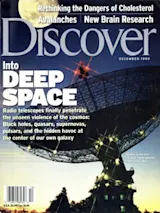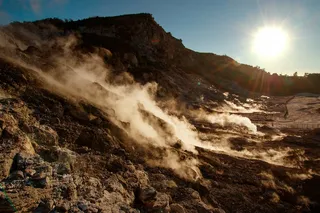December 31 marks the end of the millennium, as decreed by most members of the public, who judge these things by the turning of the numbers. Or the date is still a year away, according to the official Gregorian calendar. From an astronomical point of view, either millennium is irrelevant - a day commemorating 1,999 (or 2,000) circuits of the Earth around the sun since the incorrect birth date of Jesus, who probably was born around 4 b.c. The better time to celebrate a truly once-in-a-thousand-years event arrives some nine days earlier than the official end of the millennium.
This year's December 22 winter solstice coincides with a full moon, a combination that happens only every three decades or so. But that's not the only celestial oddity for the day: The moon also reaches perigee, its closest point to the Earth. So this solstice, which brings together the year's lowest sun and longest night, comes at the same time as the closest moon - and a full moon to boot. The last time the full moon, lunar perigee, and winter solstice fell on the same day was in 1866. Even then the moon merely reached its closest approach of the month. On December 22, the moon will be at its nearest point of the year. It's the kind of event that drove primitive cultures bonkers.
And there's more. The day of Earth's maximal tilt (when the axis is directed most fully away from the sun) will also combine with a very close sun, which reaches its nearest point to Earth 12 days later. The confluence of all these forces at the very least will brew up huge proxigean tides, also called "closest of the close moon" tides. They will extend a few, but crucial, inches farther than normal, ranging from reach-the-boardwalk highs to lows that uncover rarely exposed marine life. Add a low-pressure storm at sea to the day, and coastal damage will be unusually likely. Oceans act like the mercury in a barometer, rising in response to reduced air pressure. Accompanying onshore winds lift the waters much farther. A little meteorological nudge could push strong tides over the edge. Even earthquakes occur more often during strong tides, although it's a weak effect.
The cosmic culprits responsible for all this drama - the moon and the sun - occupy opposite ends of the sky on December 21 and 22. A full moon will rise just as the sun goes down at its leftmost position of the year along the horizon. This exceptionally plump moon will seem 14 percent wider than it appeared when it was at apogee, its farthest point from Earth, on December 8. Long ago and early on in the experience of using calendars, year's end always coincided with the winter solstice. That changed during the switch from the Julian to the more accurate Gregorian calendar, beginning in the sixteenth century. What seems to have been lost was a much more appropriate time, from a celestial point of view, to celebrate the passing of 1,000 years - on December 22, when the sun, moon, and Earth perform a genuinely once-in-a-millennium dance.














